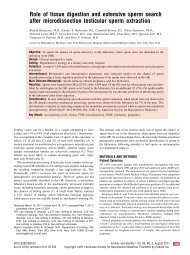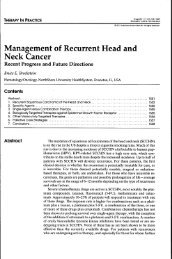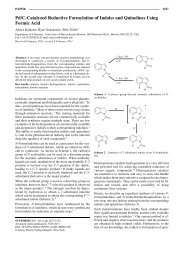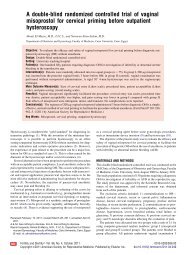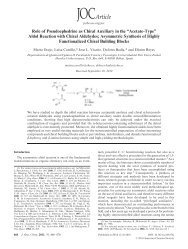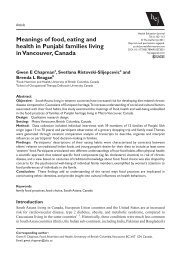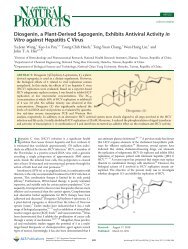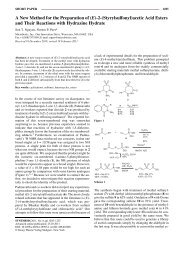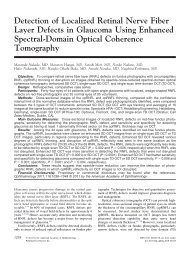Unusual Tigliane Diterpenes from Euphorbia grandicornis
Unusual Tigliane Diterpenes from Euphorbia grandicornis
Unusual Tigliane Diterpenes from Euphorbia grandicornis
Create successful ePaper yourself
Turn your PDF publications into a flip-book with our unique Google optimized e-Paper software.
Journal of Natural Products ARTICLE<br />
Table 1. NMR Data of Compounds 1 and 2 [500 MHz ( 1 H),<br />
125 MHz ( 13 C), CDCl 3, δ (ppm) (J = Hz)]<br />
position<br />
1 H<br />
1 2<br />
1 7.65 s 159.9 7.58 s 159.7<br />
2 134.8 133.9<br />
3 204.8 206.9<br />
4 72.8 71.9<br />
5 6.90 s 137.3 6.04 s 126.8<br />
6 147.9 150.0<br />
7 201.4 4.65 d (9.4) 83.1<br />
8 3.53 d (5.5) 54.6 2.60 dd (9.4, 5.4) 45.6<br />
9 73.2 72.6<br />
10 3.32 brs 58.6 3.07 s 56.7<br />
11 2.08 m 38.2 2.08 m 37.8<br />
12β 2.10 m 31.5 2.18 dd (11.8, 4.3) 31.5<br />
12R 1.62 dd (14.0, 11.0) 1.60 dd (14.9, 11.8)<br />
13 62.7 63.3<br />
14 1.95 d (5.5) 20.8 1.71 d (5.5) 27.0<br />
15 25.8 25.4<br />
16a 4.17 d (11.5) 69.0 4.51 d (11.3) 70.3<br />
16b 4.07 d (11.5) 3.99 d (11.3)<br />
17 1.16 s 11.1 1.13 s 11.2<br />
18 0.96 d (6.4) 18.5 0.94 d (6.5) 18.5<br />
19 1.83 d (1.5) 10.0 1.80 d (1.4) 9.8<br />
20a 4.37 d (14.2) 63.7 2.04 s 22.3<br />
20b<br />
isobutanoyl<br />
4.25 d (14.2)<br />
10 178.8 178.8<br />
20 2.54 sept (7.0) 34.2 2.56 sept (7.0) 34.0<br />
30 1.15 d (7.0) 18.5 1.13 d (7.0) 18.5<br />
40 angeloyl<br />
1.15 d (7.0) 18.5 1.14 d (7.0) 18.5<br />
100 167.7 168.0<br />
200 127.5 127.0<br />
300 6.09 q (7.3) 137.8 6.08 q (7.2) 139.0<br />
400 1.97 dd (7.3, 1.5) 15.8 1.96 dd (7.2, 1.1) 15.7<br />
500 1.88 s 20.4 1.87 s 20.0<br />
OH-4 2.67 s 2.23 s<br />
OH-7 8.52 s<br />
OH-9 6.09 s 5.73 s<br />
OH-20 2.37 s<br />
Compound 1 was isolated as a colorless, amorphous solid. Its<br />
positive ion ESIMS displayed a quasimolecular ion peak at m/z<br />
553 [M þ Na] þ , indicating a molecular mass of 530, corresponding<br />
to the formula C29H38O9, which was supported by HR-<br />
ESIMS (m/z 553.2425, calcd for 553.2408, C 29H 38O 9Na). The<br />
1 H and JMOD NMR spectra exhibited typical resonances for<br />
isobutyrate [δH 2.54 sept (1H), 1.15 d (6H); δC 178.8, 34.2, 2<br />
18.5] and angelate [δ H 6.09 q (1H), 1.97 dd (3H), 1.88 s (3H);<br />
δC 167.7, 137.8, 127.5, 15.8, 20.4] ester groups (Table 1). In<br />
addition, with the aid of the JMOD, 1 H- 1 H COSY, and HSQC<br />
spectra, eight quaternary carbons, six methines, three methylenes,<br />
and three methyl groups were detected, accounting for a<br />
20-carbon-containing diterpene skeleton. Analysis of the 1 H- 1 H<br />
COSY spectrum provided only a little more information on the<br />
13 C<br />
1 H<br />
13 C<br />
partial structures. Two isolated methylenes [δH 4.17 and 4.07 d<br />
(J = 11.5 Hz), 4.37 and 4.25 d (J = 14.2 Hz)] and the following<br />
short structural fragments were elucidated on the basis of the<br />
correlated proton sequences: CH3-CH-CH2- (unit A, δH<br />
0.96 d, 2.08 m, 2.10 m, and 1.62 dd), -CH-CH- (unit B, δ H<br />
3.53 and 1.95 d), and -CH-CHd (unit C, δH 3.32 brs and<br />
7.65 s). The carbon resonances at δC 201.4 and 204.8 demonstrated<br />
the presence of two keto groups in the molecule. Furthermore,<br />
two trisubstituted olefins were evident <strong>from</strong> the carbon<br />
resonances at δC 137.3, 147.9, 159.9, and 134.8 and the proton<br />
resonances at δH 7.65 and 6.90 s. One of these units, together with<br />
a methyl (C-19), a keto group (C-3), a methine (C-10), and a Osubstituted<br />
quaternary carbon (C-4), comprised a methylsubstituted<br />
five-membered ring, characteristic of 4-hydroxyphorbol<br />
esters, as proved by the HMBC correlations detected between<br />
H-19/C-1, H-19/C-2, and H-19/C-3. The other trisubstituted<br />
olefin was placed at positions C-5-C-6, since heteronuclear longrange<br />
correlations were detected between H-5 and C-10 and<br />
between H-5 and C-3 in the HMBC spectrum and allylic coupling<br />
between H-5 and H-20 in the 1 H- 1 H COSY spectrum. The<br />
quaternary carbon at δC 73.2 (C-9) showed two- and three-bond<br />
correlations to the protons of unit A [δ H, 2.08 m (H-11) and<br />
0.96 d (H-18)], suggesting that this structural fragment represents<br />
the C-18-C-11-C-12 part of a 9,13-substituted tigliane diterpene.<br />
The two methine groups containing unit B were assigned as<br />
the C-8-C-14 part of the molecule and confirmed <strong>from</strong> the<br />
HMBC correlations between H-8 and C-9, H-14 and C-13, H-14<br />
and C-15, and H-8 and C-15. The presence of a keto group (δ C<br />
201.4) at C-7 was concluded on the basis of the H-8/C-7 and<br />
H-14/C-7 long-range correlations, and the 16- and 20-methylenes<br />
were corroborated by the HMBC cross-peaks between H-5/C-20,<br />
H-16/C-15, H-16/C-17, and H-17/C-13. The position of the<br />
angeloyl group at C-16 was evident <strong>from</strong> the three-bond correlation<br />
between the ester carbonyl carbon (δC 167.7) and the H2-16<br />
protons (δ H 4.07 and 4.17 d). Hydroxy groups at C-9 and C-20<br />
were deduced <strong>from</strong> the NOESY correlation between the OH<br />
group (δH 6.09) and H-10 and H-12b and the 1 H- 1 HCOSY<br />
correlation between OH group (δ H 2.37) and H-20 protons,<br />
respectively. The location of the isobutanoyl group at C-13 was<br />
determined on the basis of the chemical shift value of C-13 (δC<br />
62.7 ppm), which was in the usual range of 13-acyl-substituted<br />
phorbol esters (δC 62.7-63.6 ppm). 9-11<br />
The relative stereochemistry of 1 was elucidated by analyzing<br />
the correlations detected in a NOESY spectrum (Figure 1). NOE<br />
interactions between H-8 and H-11, H-8 and H 3-17, H 3-17 and<br />
H-12β, and H-12β and H-11 indicated the β-position of all these<br />
protons and the methyl group. On the other hand, NOESY crosspeaks<br />
between H-12R and OH-9, OH-9, and H-10; H-10 and<br />
H-1; H-1 and H-18,; and H-16a,b and H-14 dictated an Rarrangement<br />
of H-10, OH-9, H-14, and the C-16-methylene and<br />
C-18-methyl groups. The trans A/B ring junction with H-10R<br />
and OH-4β and the 13-acyl group in an R-position were<br />
concluded on the basis of biogenetic considerations, since all<br />
phorbol-type diterpenes isolated so far have such functionalities<br />
and because the C-4, C-10, and C-13 chemical shift values of 1<br />
were in good agreement with those of structurally related<br />
compounds. 10,12,13 All of the above data were compatible with<br />
the structure of 1 being proposed as 16-angeloyloxy-13R-isobutanoyloxy-4β,9R,20-trihydroxytiglia-1,5-diene-3,7-dione.<br />
Compound 2 was isolated as a colorless oil. Its molecular<br />
formula was assigned as C 29H 40O 8 on the basis of the HRESIMS<br />
and NMR data. The 1 H NMR and J-modulated 13 C NMR<br />
640 dx.doi.org/10.1021/np100673s |J. Nat. Prod. 2011, 74, 639–643



